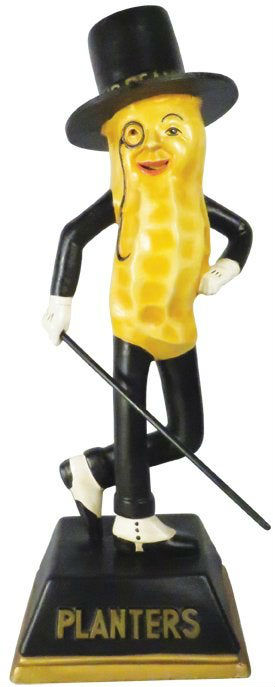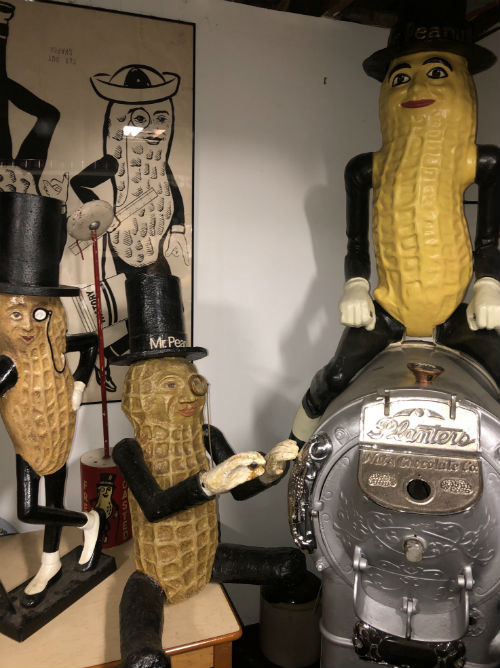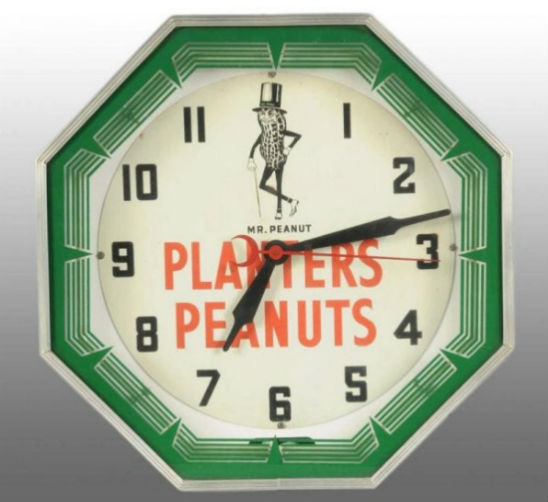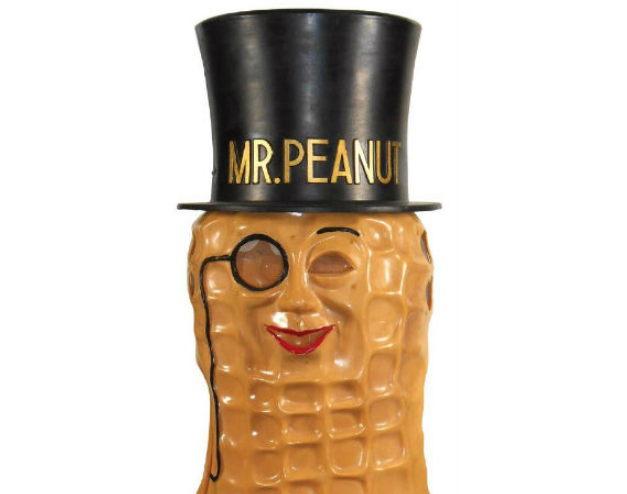
NEW YORK – One of America’s earliest advertising icons, Mr. Peanut was born in 1916 when a 14-year old Virginia boy, Antonio Gentile, won a sketch contest sponsored by the Planters Peanut Co. to create a new brand icon. Cutting an athletic and dapper figure, Mr. Peanut received his famous top hat, monocle and cane from an advertising agency, lending him an air of sophistication. Over the last 100+ years, his look has changed little and he even has his own fan club.
Collectors eagerly shell (pun intended) out big bucks for Mr. Peanut figures, roasters and store display items as well as collectibles such as banks, toys, lithographed tin objects, mugs and salt and pepper shakers.
At its peak, the Planters company had about 200 stores around the country with its largest retail stores on the boardwalk in Atlantic City and in New York’s Times Square, complete with photogenic large neon signs featuring Mr. Peanut. The company’s first Times Square billboard went up in 1937-38.

Store-owned display items are a favorite of advertising collectors and scarcity always fuels demand. When the Planters brand and its stores changed hands, any brand advertising that predated the sale became highly valuable.
“When the stores were sold to Standard Brands in the early 1960s, Mr. Peanut went from a realistic-looking peanut man to a cartoonish blue and yellow figure,” said Mr. Peanut Collectors Club president Scott Schmitz in a 2016 interview with Advertising Week. “As part of that transition, Planters destroyed a lot of merchandise in the stores since the ‘old Mr. Peanut’ was not part of the sale to Standard Brands. Only a handful of these items survived.” Several store owners were later discovered to have hid certain unique items to prevent their destruction. Years later, these items are highly sought after by buyers.
Angel Schmitz, the club’s vice president and editor, notes that advanced collectors, dubbed “Peanut Pals,” aspire to acquire one-of-a-kind pieces. “Therefore, paper goods will be highly prized (early 1900s boxes, signs and letters), as well as the large-ticket items such as a Blinker, Tapper or Roaster with Rider,” she said. A tapper, for example, was used to tap on a store window to attract attention and invite customers to come in.

Much of the appeal of Mr. Peanut merchandise lies in nostalgia. Many children grew up eating Planters peanuts whether at home, at the beach or at baseball games or seeing him in the Macy’s Thanksgiving Day parade (his debut here was 1997). “I think that collectors gravitate toward their memories; therefore, quite often the very ‘collectable’ items tend to be those items they grew up with as children,” she said. Favorite items collected include plastic mugs, banks and salt and pepper shakers. Some collectors only seek out plastic items, usually brightly colored, while others focus on paper ads or cardboard displays and boxes.

Mr. Peanut advertising spans the decades so what era collectors prefer to collect largely comes down to personal taste. “I enjoy pre-WWII items, as well as my favorite piece, an inexpensive ashtray, 1950s, showing the Atlantic City boardwalk,” Angel Schmitz said, noting an ashtray in her collection that originally sold for 19 cents would realize between $200 and $300 today, depending on condition. “We have Pals that focus on plastics [1950s through 1990s], current items [1990s to today] or folks that like household goods [i.e.: Nabisco era]. Mr. Peanut was a step in front of the majority of companies as far as advertising and promotions go.”

From his appearance at the New York World’s Fair in the 1960s to the peanut-shaped Nutmobile that tours the country today, Mr. Peanut has been a perennially popular advertising icon. Planters first advertised in the Saturday Evening Post in 1918, becoming the first to advertise roasted nuts, and Mr. Peanut was inducted into Madison Avenue’s Advertising Walk of Fame in 2004, according to the Planters company timeline. While the dapper Mr. Peanut is commonly known by his nickname, few know his given name, which, in keeping with his identity as a refined gentleman of British descent, is Bartholomew Richard Fitzgerald-Smythe.
Befitting his status as a brand icon, his look and style hold timeless appeal, says Angel Schmitz said. “His fabulous smile, warm and welcoming posture and open arms encourage anyone to take a moment to observe the mascot and hence, the tasty and timely products.”
# # #



